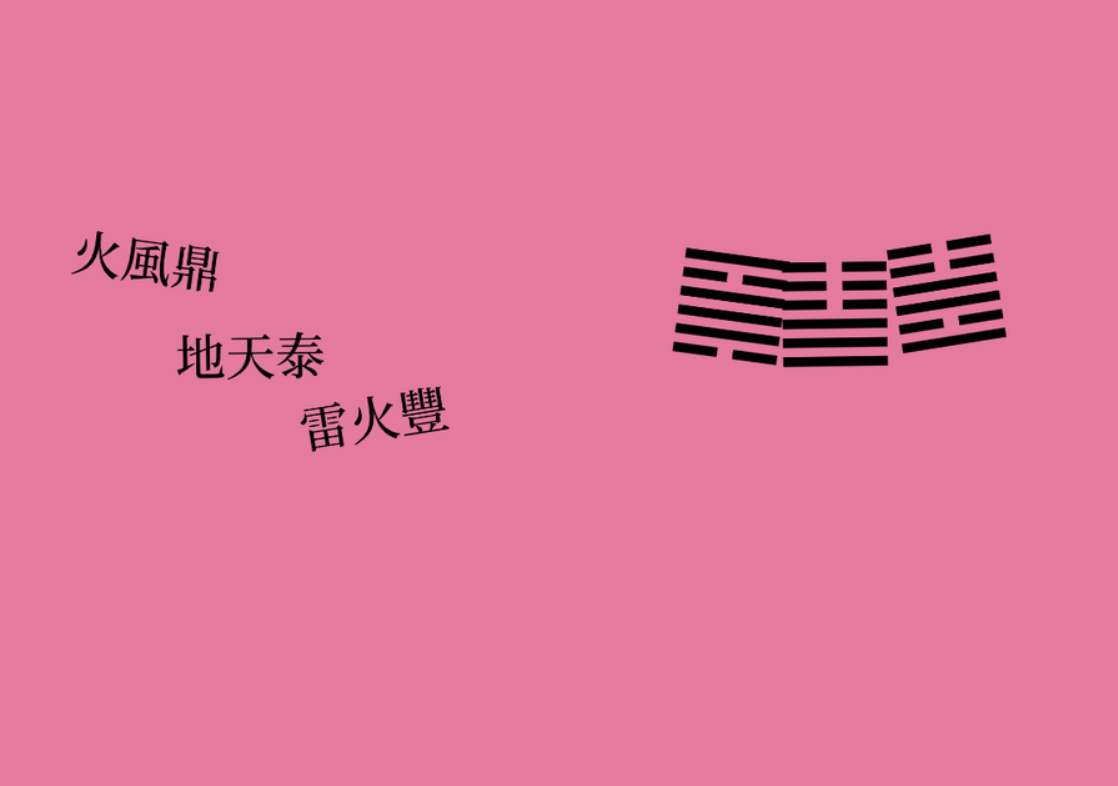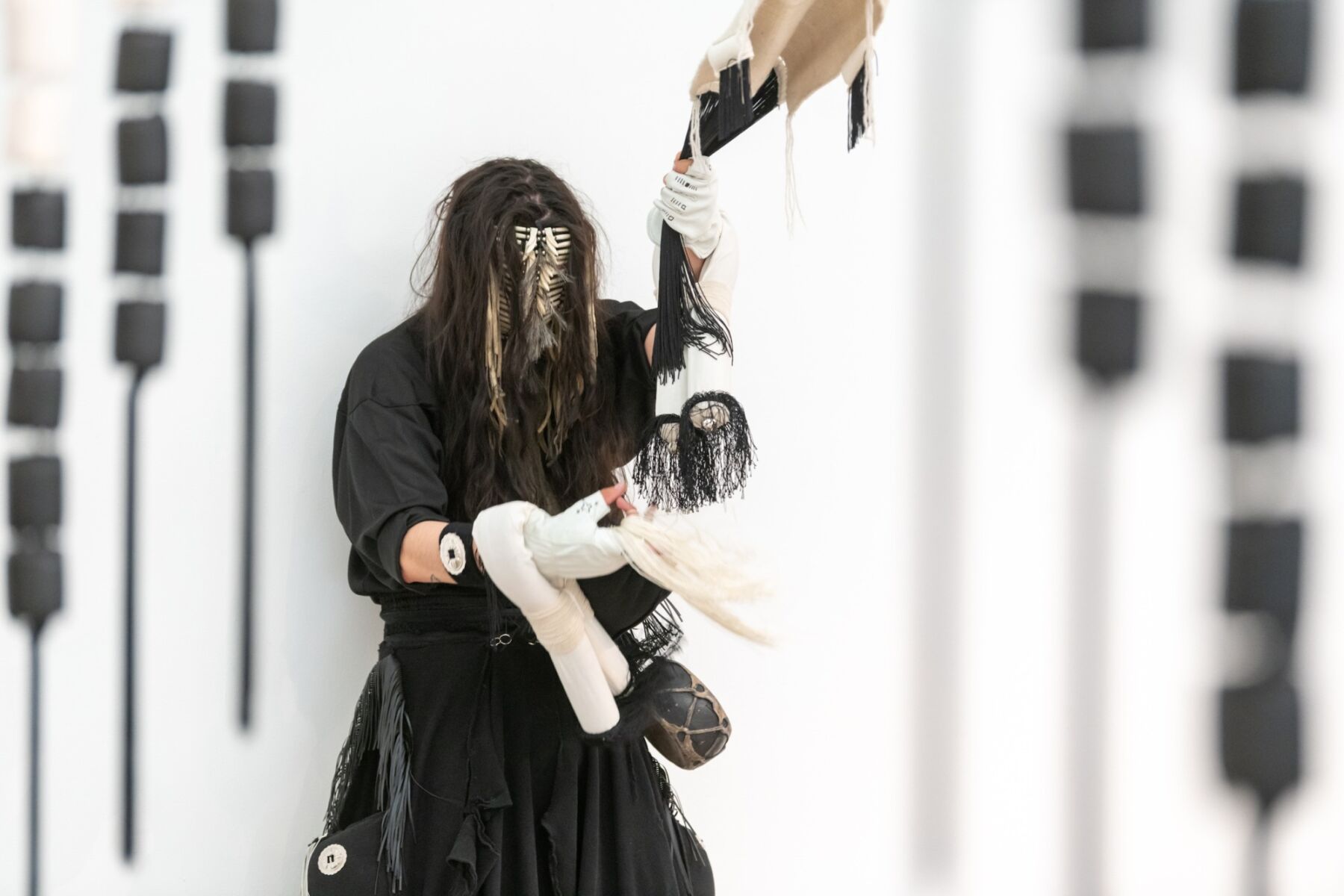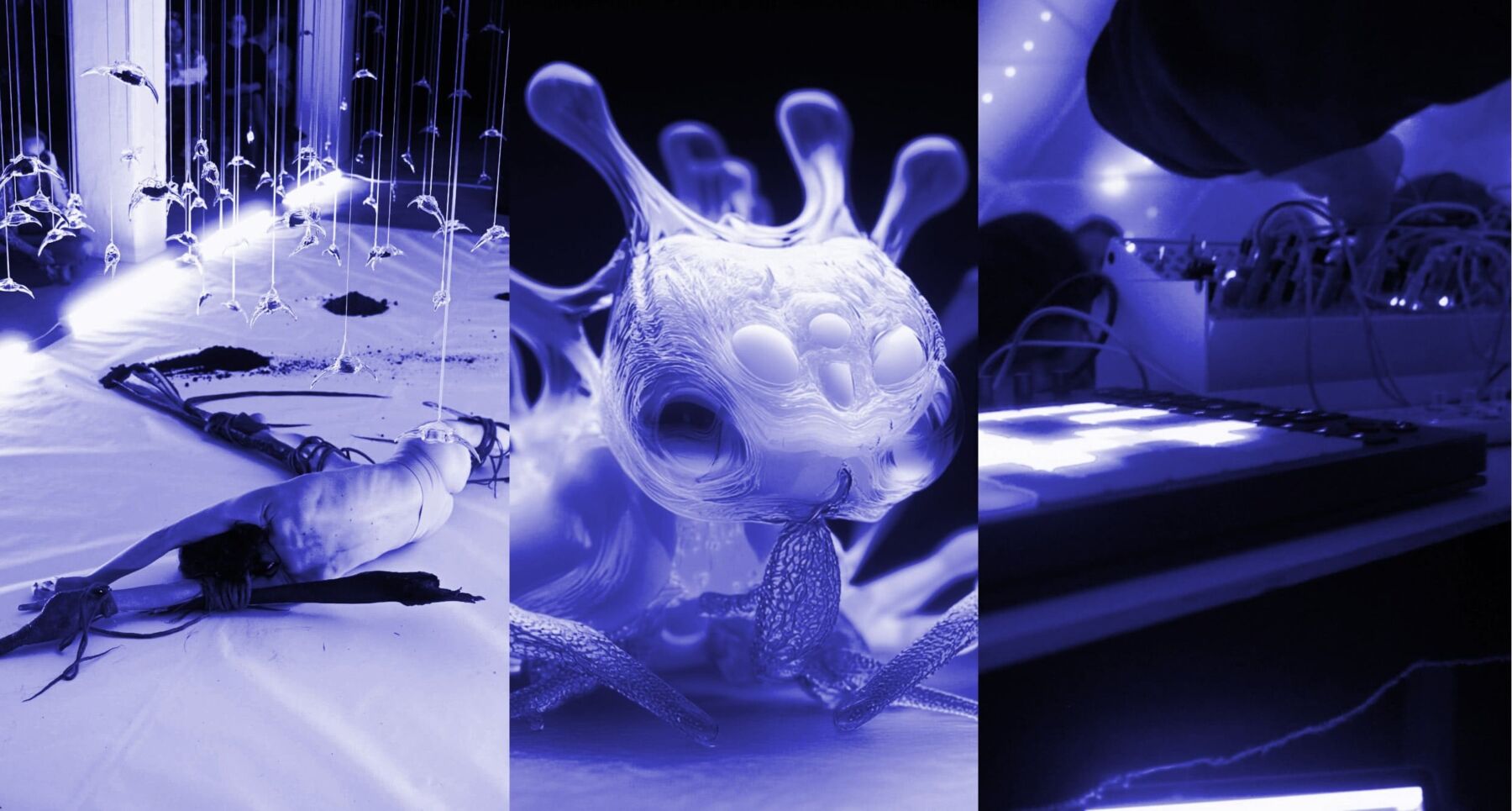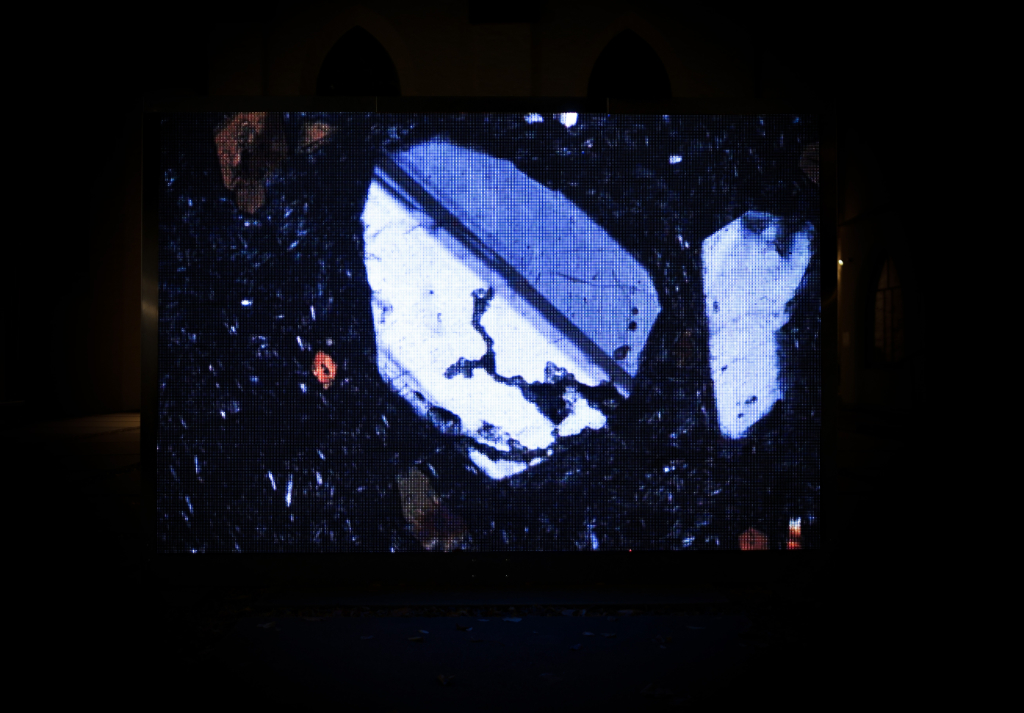Interview by Lula Criado
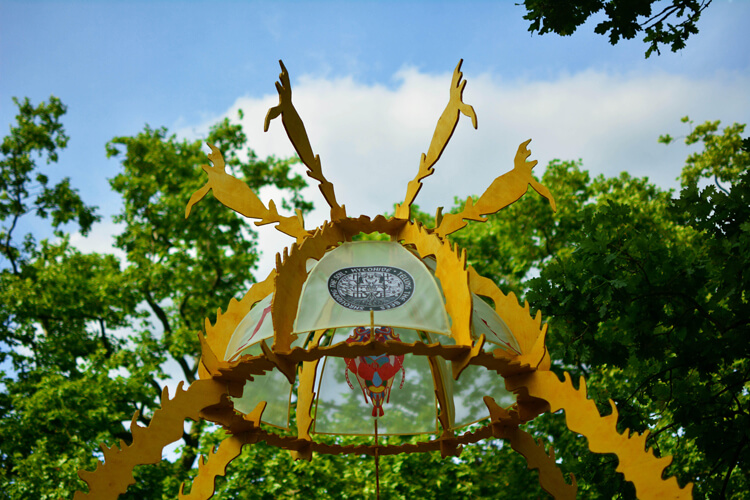
Human beings communicate with each other through gestures, smells, noises and sounds before acquiring the ability to use speech for communication. Baum & Leahy (Amanda Baum and Rose Leahy) is an award-winning international studio exploring biophilic, collaboratively-driven artistic creation through interactive installation, art direction, scenography and experience design.
In their project Akouo: Memory Object (2016), a collaboration with Jolien Van Schagen, the three were inspired by the fact that ‘when a sound is made, it never disappears from the environment it was made in’. They imagine a future scenario where sound is a ‘mediator for social interactions’. The sculpture is a loop system with a microphone embedded that, without any interruption, records and plays out surrounding sounds.
At this year’s Royal College of Art Graduation Show, Baum & Leahy presented their graduation project Mycohive: Telling the Bees, Shrouding the Soil. Recent studies show that Reishi (Ganoderma Lucidum), a mushroom known by its immunological properties, is one of many that can protect honey bees from Varroa mites, a parasite that sucks bee blood and is the most prevalent cause of honey bee colony collapse1.
Mycohive: Telling the Bees, Shrouding the Soil2 follows this scientific research on the immunological benefits of mushrooms and pagan rituals to explore the symbiotic relationship between plants, bees and mushrooms. Other projects that caught my attention were Phonoculos (2015) and, more recently, they presented The Alien Present (2017) as part of Entangled: Art, Science and Quantum Computing at the V&A Museum (London). Phonoculos, a collaboration with Olle Alm and Annelise Keestra, is inspired by the chemical pheromone communication between ants.
Pheromones are at the tips of the antennae and help the ant choose the turn. From this idea, the four created an installation in which participants wore a helmet —the Phonoculos helmet— that diminished their vision, so they have to move around by sound rather than sight. At TheFinally, alien Present, an interactive sculpture made from a quantum random walk simulation*, they imagine a future scenario in which quantum computing is influenced by ‘the caring, nurturing practice of gardening’ to explore our relationship with emerging technologies such as quantum computing.
Ecology and how humans relate to are central axes of Amanda and Rose’s artistic practice. They focus awareness on pointing out the connection humans have with other species making us think that a future in which humans live in harmony with and respect for the Earth is possible.
Baum & Leah continue their collaborative practice during a residency with the Florence Trust in London starting in Autumn 2017. Also, they have just begun a long-term collaboration with Øyteateret in Oslo and an upcoming collaborative project with Danish publishing and curatorial platform Laboratory for Aesthetics and Ecology.
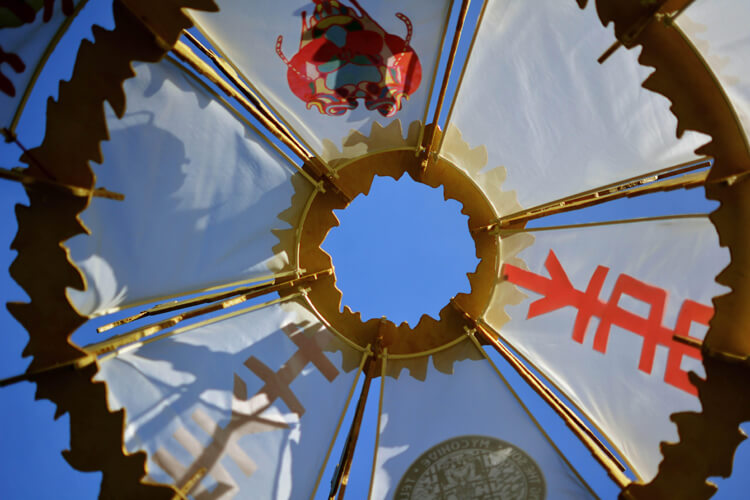
Your graduation project at RCA, Mycohive: Telling the Bees, Shrouding the Soil, explores how human rituals can trigger and help remediate symbiotic relationships between mushrooms, bees and plants. How did you come up with the idea for those unfamiliar with your work? And where does the interest in these organisms come from?
The Mycohive project emerged from an ongoing fascination with collective behaviour – in mycelial networks, hive mind dynamics, swarm architecture, interspecies symbiosis and symposia (living and making with), as well as complexity research, which is what weaved so many topics into one work.
Amongst the many attractive species to study, we have always been drawn to the superorganisms of insect and fungal communities, from the wonders of waxy honey bee hives to the moist underground network of the Wood Wide WeHowever, a. A turning point in the project was when we found that, in addition to securing the health of their ecosystems, these superorganisms interact in a healing relationship together.
Mycologist Paul Stamets’ recent research shows how honey bees use certain mushroom species to self-medicate against viruses spread. The Varroa mite spreads position to current techniques employed to combat these viruses, using mycelium extract from medicinal mushrooms, such as reishi, chaga and amadou, has proven to be both highly efficient and environmentally harmless.
This struck us as an exciting mode of earthly survival through interspecies healing and inspired us to translate their interconnected material, sensorial worlds into a human-scale Experience. However, the project started to form once we combined this contemporary science with research into healing and transformation rituals practised through time and across many different cultures, particularly the folklorish tradition of ‘telling the bees’.
In this, the beekeeper’s family would inform the hive of a death or a change in their keeper’s lives by performing different rituals such as singing them a rhyme, shrouding the hive and offering them funereal sweets. In Ancient Near Eastern and Aegean traditions and myths, bees have been considered the bridge between this life and the ‘afterlife’. In a more literal sense, these qualities are similar to how fungal communities transform dead matter into new life.
We see our project as a materialised love letter to these species we are so vitally entangled with but also constantly afraid to lose – or be dumped by. Even tSo evenh we believe that life will continue and change in unpredictable ways with or without us, we hope that Mycohive can bring to light all the under-explored acts of survival happening right now.
In creative practices engaging with scientific research, we see a lot of projects where biological organisms are taken out of their habitat to become works of art or design. However, what I found the most interesting for this project is how we can create structures and systems supporting how these organisms already live and have evolved to work over millions of years.
You continued your collaborative practice during a residency with the Florence Trust (London). Could you tell us about the work/projects you are developing there?
We are still working with the Mycohive, which will ideally travel to environmentally damaged sites where soil health and bee populations have been affected, as well as to shorter-term exhibitions and events. The structure works as a suitable place for performing the bioremediation and a communal place for hosting workshops, rituals and gatherings that inspire discussions around the topic.
The Mycohive structure is a flat pack, so it’s easy to set up and travel to many places. With more time now to work in depth with both scientific and artistic aspects, and some exciting opportunities emerging, we hope the project can act as a model of how environmental action can be married with ceremonial celebration.
Additionally, we have just begun a long-term collaboration with Øyteateret in Oslo, working on Opphav, a puppet show written by playwright Amalie Olesen which follows the development of microbial life from primordial soup through evolution into a speculative, more-than-human, sci-fi future. The project is based on Lynn Margulis’ theory of symbiogenesis.
Using puppet theatre to story-tell about microbial life has proved a perfect match so far, as both theme and form remove the centrality of the human, allowing for materials and nonhumans to take centre stage. Alongside our practical projects, research and writing will be essential in our work.
One upcoming project is to collaborate with Danish publishing and curatorial platform Laboratory for Aesthetics and Ecology on publishing an edited version of our collective dissertation Weaving Worlds, written by the two of us, fellow RCA’er and collaborator Robert Walker, and a machine learning algorithm programmed to deconstruct our texts and find latent semantic patterns between them.
The idea emerged from the need to disrupt purely human logic and intellect and by bringing in other forms of logic, using technology as a gto understand than-human matters. While working on these projects, we continuously aim to spend time giving names, shapes, and colours to our collective studio. But, apart from these plans, we stay open to the unexpected.
What impact do you think the residency will have on how you approach your art form?
The Florence Trust residency allows us to work in-depth on projects that require long-term experimentation and research. For the first time, we have a studio together where we can slime out in many directions, experiment and work more patiently to allow materials, images, text and colour to build up in the space.
We imagine the building will impact our process – St Saviour’s is a neo-Gothic Grade I-listed church designed by William Whyte, embellished with stained-glass stories and painted pattern walls. In addition to the crisp church atmosphere and singing silence filling the 20m-tall room, there’s a beautiful wild garden surrounding the building, which we are looking also g forward to working in as well.
Apart from the direct creative influences, the residency will be an excellent opportunity for bridging study and professional life. We’re looking forward to having time and space to work on more considerable commission work and exhibitions, along with the support of the mentorship we will receive there.
Additionally, we will be in a creative community – the residency will be shared with eleven other artists working broadly across many subjects and media, creating many opportunities to cross-pollinate ideas and critiques from outside our bio bubble.
What is more important: to take or not take yourself too seriously creative?
One of our mantras is to take pleasure seriously. WhileSo, whilst severe environmental issues can be heavy, we try to tackle the subject with poetry, humour and openness. Our intuitive approach feeds into our work, attracting and inspiring people to engage in conversations about all the opportunities for solutions rather than dwelling in the same old dirty sludge of hopelessness and despair.
We aim to mimic the pioneering spirit of the organisms we study – they don’t have time to take themselves too seriously; there’s too much to do. All that said, we take seriously the microbes in each other. We’re very grateful that they’ve evolved for nearly 4 billion years to appear exactly here and now in our brief human symbiotic practice.
If you could visit someone else’s mind, who would it be?
Without sounding too Disney, the Mycohive really grew out of each of our personal affections with and interests in these organisms, so right now, we would like to visit the umwelt of bees and mushrooms. As art and design researchers working on weaving together the human and nonhuman scales of experience, at the heart of our creative drive is to practice interspecies empathy.
We’ve speculated a lot about the experience of being another species – we colour co-ordinated the Mycohive to appeal to the visual spectrum of honey bees, listened to the sound of humming bee hives, did mushroom-style networking and in the heat of it all, one of us even dreamt of being mycelium moving through the soil… But, if it had to be human minds, we would like each veitherHaraway or Karen Barad’s head and go for a drink together.
One for the road… What are you unafraid of?
Moist.


